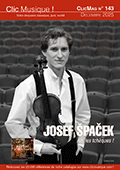 Composées en 1923, les deux premières sonates pour violon et piano de l'américain George Antheil incarnent le langage d’avant-garde cher au jeune compositeur provocateur qu’il était à l’époque. Piano traité comme une percussion, écriture en blocs, motifs répétitifs obsédants, rythmiques aux allures industrielles, exploitation extrême des possibilités expressives des deux instruments, polytonalité, emploi de rythmes et airs populaires, voilà ce qui caractérise leur style explosif. La deuxième sonate en un mouvement de huit minutes s’apparente à une danse déstructurée sur des rythmes syncopés enjoués avec une fin surprenante. La troisième sonate (1924) se fait plus sage. Basée sur un motif thématique exploité durant les dix-huit minutes de son seul mouvement, elle se veut plus mélodique et de caractère mélancolique avec quelques ruptures rythmiques et aspects populaires dansants. La quatrième sonate (1948) fut composée après qu’Antheil remit en question son esthétique novatrice et provocatrice de ses années de jeunesse et l’intitula « Nouvelle deuxième sonate ». Sous ses allures plus classiques, elle n’en est pas moins moderne. L’écriture mélodique y est plus développée. On saluera la performance des interprètes apportant l’expressivité nécessaire à ces œuvres exigeantes. (Laurent Mineau)  A double life. Like his friend and colleague Miklós Rózsa, George Antheil (1900-1959) had a double life. Not only because he – like Rózsa – scored dozen of films and at the same time strove to be recognized as a “classical” composer, but also because he led two different existences, before and after WWII. In the twenties, Antheil was trying to establish his reputation as the torchbearer of the avant-garde: he lived mostly in Europe, scandalizing the public with his iconoclastic music and furiously percussive piano playing. His most famous compositions—the piano sonatas Airplane, Sauvage and Death of the Machines, his violin sonatas and the Ballet mécanique scored for 16 player-pianos, xylophones, and percussion—all evidence a futuristic aesthetic theory, influenced mostly by Bartók, Ornstein and Stravinsky. However, in a dramatic turn following a profound personal and artistic crisis, Antheil re-emerged, now in his early forties, as a neo-romantic, fullyintegrated American composer, even, to some extent, a conservative. The four sonatas in this first volume of his violin music exemplify the two periods of his creativity. They document Antheil's musical evolution from the percussive First, to the Dadaist-cubist Second and the more neoclassical Third. A hiatus of 25 years separate these early scores from the socalled Second Violin Sonata (i.e. his Fourth Sonata), composed in 1947-48, which is clearly a more classically structured composition. While the three pieces composed between 1923 and 1924 (the Third) emerged from a pervasive influence of Stravinsky's early masterpieces, the Fourth Sonata is more under the spell of Prokofiev and Shostakovich. To Antheil, the Russians served, paradoxically, as models for a possible American music, mostly because they did not give up tonality, they knew too well how to handle (and hide) folkloric material and they could at the same time counterbalance what Antheil considered the pernicious influence of Schoenberg's twelve-tone.
 |
